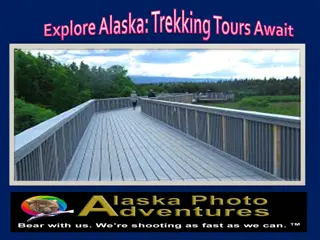IL-STAND Program Needs Assessment for Alaska Natives with Disabilities
The IL-STAND Program aims to identify barriers for Alaska Natives with disabilities through a partnership with the Alaska Native Elders Care. The project, supported by federal grant 90IL0356-01-00, focuses on developing culturally appropriate strategies to increase capacity in providing independent living services to Alaska Natives. Key goals include understanding service needs, enhancing cultural competencies, and disseminating best practices for replication.
Download Presentation

Please find below an Image/Link to download the presentation.
The content on the website is provided AS IS for your information and personal use only. It may not be sold, licensed, or shared on other websites without obtaining consent from the author. Download presentation by click this link. If you encounter any issues during the download, it is possible that the publisher has removed the file from their server.
E N D
Presentation Transcript
Independent Living Services To Alaska Natives with Disabilities (IL-STAND) Program Needs Assessment Launch identifying IL barriers for Alaska Natives supported by federal grant 90IL0356-01-00. Research partnership with the Alaska Native Elders Care (ANEC) Presented at the APRIL Conference 10/06/18
Your Presenters: Gail Dabaluz, IL-STAND Program Coordinator Joan O Keefe, SAIL Executive Director
PRESENTATION OVERVIEW Context: Where and Why ACL NAILD Project Proposal Challenges Lessons Learned Other Possible Take-Aways Q & A 3
SAIL IN A NUTSHELL CIL, incorporated 1992 Aging and Disability Resource Center, 2007 Serving 1200+ Elders and PWD Consumers in 18 communities
NATIVE AM. IL DEMONSTRATION PROJECT (NAILD): IL-STAND The SAIL Board of Directors, Executive Director, and staff identified a need to work with rural Alaska to better provide Independent Living (IL) services for Alaska Natives. This long-held goal resulted in a grant proposal submitted to the Administration on Community Living. Three projects chosen in round one. SAIL received a 3-year award, to work with 6 communities: Angoon, Hoonah, Hydaburg, Kake, Klawock, and Yakutat. Two more recent round. 8
IL-STAND PROGRAM GOALS Develop and implement culturally appropriate strategies; Increasing capacity to deliver Independent Living services to Alaska Natives residing in southeast Alaska with disabilities; and Disseminate lessons learned and best practices for replication. 10
PROJECT GOALS AND OBJECTIVES Increase understanding of service needs of Alaska Natives with disabilities. This can improve cultural competencies of SAIL staff and build capacity to deliver all 5 core services; 1. Advocacy. 2. Independent Living (IL) Skills, 3. Information/Referral. 4. Peer Support. 5. Transition. In each target community and disseminate lessons learned and best practices. 11
ANTICIPATED OUTCOMES SAIL staff will demonstrate an increase in cultural competencies; Alaska Natives with disabilities residing in six (6) target communities will self-identify an increase in: Awareness of IL services; Personal independence as a result of IL service delivery; and Satisfaction with CIL services. 12
PRODUCTS TO BE DEVELOPED A sustainability plan to support the project in the future. Through dissemination of best practices and lessons learned, CILs outside of our service area will learn to better serve people with disabilities in Tribal villages and Reservations. A formal paper capturing lessons learned and best practices will be developed. We plan to work w/ IRLU on dissemination. Presentations at The Independent Living (NCIL); and Associated Programs for Rural Independent Living (APRIL) conferences. National Council on 13
LOCAL INPUT The project will require: Local input and participation to examine barriers to Independent Living (IL) for Alaska Natives. Review of partner organizations who provide services to them. The development of a Comprehensive Needs Survey completed by community members, identifying IL barriers. The creation of a Regional Advisory Committee to provide guidance on cultural protocols when working in rural communities. 15
RESEARCH COMPONENT SAIL is working with the Alaska Native Elders Care (ANEC) for project research. The questionnaire will identify awareness and gaps affecting IL . The Research Advisory Council, and the 6 federally recognized Tribes will influence research questions, emphasizing IL conditions in each community. Page 16
ALASKA NATIVE TRIBAL HEALTH CONSORTIUM (ANTHC) ROLE For health related research projects, ANTHC is the organization who reviews/approves/disapproves proposals. Their purpose and role for the IL-STAND project is: Assist health researchers to obtain approval for research in Alaska Native communities. Through our working partnership between SAIL and ANEC, we will submit our proposal via the Institutional Review Board (IRB). 17
ALASKA NATIVE TRIBAL HEALTH CONSORTIUM (ANTHC) ROLE This includes presenting the conceptual framework for Tribal review and approval of health research in Alaska tribal communities. It is important to demonstrate the research review and approval process of health research in Alaska Native communities. In the past, Native Americans and Alaska Natives were mistrustful of research protocols, based upon misinformation about project results given to participants and communities. 18
PARTNER AGENCY COLLABORATION Through this project: Increased IL services in rural SE Alaska. Hired one Village IL Advocate per community. 37% of our consumers are Alaska Native. Continual dialogue with our partners to increase IL services for Alaska Natives, including: Supporting use of telemedicine in communities, via SEARHC. Use of facilities with CCS/SESS and SEARHC. Increasing work opportunities, through IL Advocates in six (6) target communities. 19
LOCAL PARTNER AGENCIES Catholic Community Services - Southeast Senior Services (CCS-SSS). Central Council Tlingit and Haida Indian Tribes of Alaska (CCTHITA). https://scontent-sea1-1.xx.fbcdn.net/v/t1.0-1/c0.0.206.206/11193421_987845901234785_5959624016893317298_n.jpg?oh=427be696986c5e9ada467e0282f9e4d3oe=59D9C5C8 Tlingit and Haida Regional Housing Authority (THRHA). Southeast Alaska Regional Health Consortium (SEARHC). 20
CHALLENGES Staff changes were a soft challenge; it was just a matter of adjusting to each program director s way of doing business. Program funding carry-over budget uncertainty. Submitting our requests took a long time to officially know if the budget modifications was approved. Hiring very part-time staff in each community was tricky. 21
CHALLENGES Providing training via distance delivery. Everyone has their own level of IT capabilities; What is the best method to offer training from a distance? What training tools are available? What training tools need to be developed? Trouble-shooting staff logistics from a distance. Securing office space; How to transport office furniture, supplies to remote villages; Setting up the tools staff need on a daily basis (phone, internet); Cost of travel in SE Alaska. 22
LESSONS LEARNED Through meaningful partnerships with Tribes, we ve learned: Hiring models can use multiple approaches. Identifying community tribal needs is unique, in each village. Launching community surveys can provide great opportunities to listen to consumer feedback. Mandatory employee training on Native history, values, and culture is critical for all CIL staff. 24
OTHER TAKE AWAYS QUESTIONS AND ANSWERS 25
GUNALCHESH (THANK YOU!) Joan O Keefe, Executive Director jokeefe@sailinc.org 800-478-7245 907-523-4430 www.sailinc.org Gail Dabaluz, Project Coordinator gdabaluz@sailinc.org 800-478-7245 907-523-4432 www.sailinc.org 26























